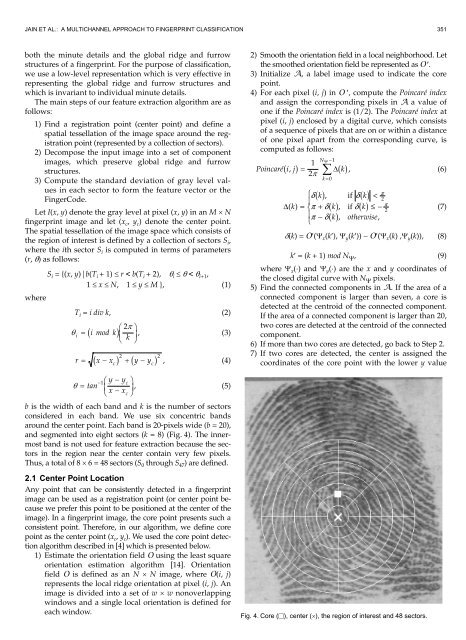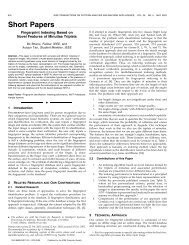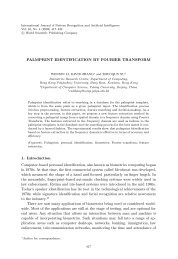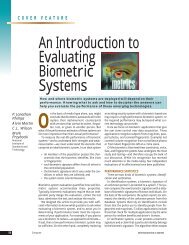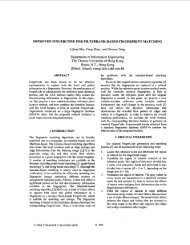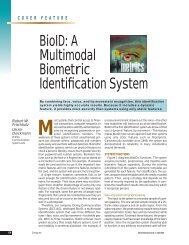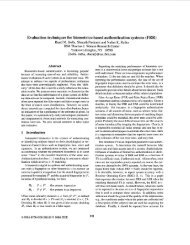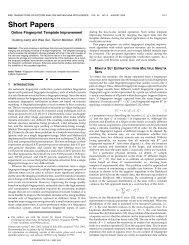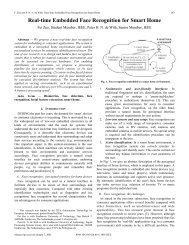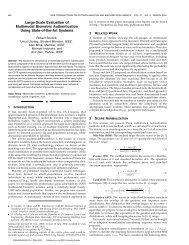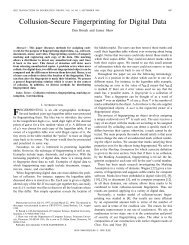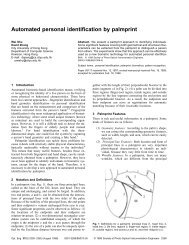A Multichannel Approach to Fingerprint Classification
A Multichannel Approach to Fingerprint Classification
A Multichannel Approach to Fingerprint Classification
Create successful ePaper yourself
Turn your PDF publications into a flip-book with our unique Google optimized e-Paper software.
JAIN ET AL.: A MULTICHANNEL APPROACH TO FINGERPRINT CLASSIFICATION 351both the minute details and the global ridge and furrowstructures of a fingerprint. For the purpose of classification,we use a low-level representation which is very effective inrepresenting the global ridge and furrow structures andwhich is invariant <strong>to</strong> individual minute details.The main steps of our feature extraction algorithm are asfollows:1) Find a registration point (center point) and define aspatial tessellation of the image space around the registrationpoint (represented by a collection of sec<strong>to</strong>rs).2) Decompose the input image in<strong>to</strong> a set of componentimages, which preserve global ridge and furrowstructures.3) Compute the standard deviation of gray level valuesin each sec<strong>to</strong>r <strong>to</strong> form the feature vec<strong>to</strong>r or theFingerCode.Let I(x, y) denote the gray level at pixel (x, y) in an M Nfingerprint image and let (x c , y c ) denote the center point.The spatial tessellation of the image space which consists ofthe region of interest is defined by a collection of sec<strong>to</strong>rs S i ,where the ith sec<strong>to</strong>r S i is computed in terms of parameters(r, q) as follows:S i = {(x, y)|b(T i + 1) ˆ r < b(T i + 2), q i ˆ q < q i+1 ,1 ˆ x ˆ N, 1 ˆ y ˆ M }, (1)whereT i = i div k, (2)p= 2 7 2 , (3)k qii mod k2 c7 2 c72 2r = x - x + y - y , (4)--q = tan 1 y yx - xcc, (5)b is the width of each band and k is the number of sec<strong>to</strong>rsconsidered in each band. We use six concentric bandsaround the center point. Each band is 20-pixels wide (b = 20),and segmented in<strong>to</strong> eight sec<strong>to</strong>rs (k = 8) (Fig. 4). The innermostband is not used for feature extraction because the sec<strong>to</strong>rsin the region near the center contain very few pixels.Thus, a <strong>to</strong>tal of 8 6 = 48 sec<strong>to</strong>rs (S 0 through S 47 ) are defined.2.1 Center Point LocationAny point that can be consistently detected in a fingerprintimage can be used as a registration point (or center point becausewe prefer this point <strong>to</strong> be positioned at the center of theimage). In a fingerprint image, the core point presents such aconsistent point. Therefore, in our algorithm, we define corepoint as the center point (x c , y c ). We used the core point detectionalgorithm described in [4] which is presented below.1) Estimate the orientation field 2 using the least squareorientation estimation algorithm [14]. Orientationfield 2 is defined as an N N image, where 2(i, j)represents the local ridge orientation at pixel (i, j). Animage is divided in<strong>to</strong> a set of w w nonoverlappingwindows and a single local orientation is defined foreach window.2) Smooth the orientation field in a local neighborhood. Letthe smoothed orientation field be represented as 2 ‡.3) Initialize $, a label image used <strong>to</strong> indicate the corepoint.4) For each pixel (i, j) in 2 ‡, compute the Poincaré indexand assign the corresponding pixels in $ a value ofone if the Poincaré index is (1/2). The Poincaré index atpixel (i, j) enclosed by a digital curve, which consistsof a sequence of pixels that are on or within a distanceof one pixel apart from the corresponding curve, iscomputed as follows:N -1Y 1Poincaré1i,j6 = Ê D1k6, (6)2pD( k)=k = 0% 16 16&K'K 16pd k , if d k


